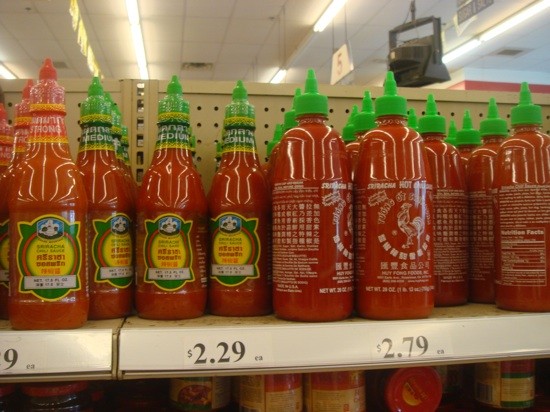
Long featured in the constellation of condiments served alongside a classic bowl of phở, the iconic rooster-labeled chili Sriracha chili sauce has developed a growing cult following among chefs, foodies and bloggers alike over the past few years. Prominently featured on the menus of star chefs likes David Chang and Jean-Georges Vongerichten, whipped into ice cream on season one of Top Chef by contestant Casey Thompson and designated by food trend watchers Andrew Freeman & Co. as “the new salsa” in its 2010 Trend Watch List, the chili-and-vinegar paste has moved far beyond Little Saigon. Did we mention it's the only condiment offered alongside Kogi tacos? As with any food “trend,” Sriracha is sure to reach an over-saturation point and will inevitably receive some sort of backlash, but for the time being, its hard to hate on the sauce being a popular item, as it's a fairly equal-opportunity, taste-enhancing condiment. A squirt or more added to any number of dishes–regardless of the ethic origins–lends a wonderful bit of heat and acid. But the bottle with its rooster logo, as synonymous with Sriracha as Heinz's 57s are with ketchup, is not only an American product, but is far from being the only red chili sauce by that name. The moniker comes from the chili pastes produced in and around a town in Chonburi Province, Thailand, called Sriracha. Confused yet?
History is all fine and good (and very interesting), but here at Stick a Fork in It–especially in a Dueling Dishes post–it all comes down to taste, which is why we found it necessary to pit the ubiquitous Huy Fong Sriracha with a Thai-imported brand, Grand Mountain Sriracha.
]
Matching up two iterations of a condiment is somewhat difficult to do, as by their nature, condiments live and die by the dish they're accompanying. But in the interest of tasting the sauce itself and not, say, the bowl of phở it was squirted in, both were eaten atop a mound of simple, straightforward steamed rice–which doesn't make a bad lunch, if you're wondering.
The taste of Huy Fong Sriracha was as expected: the burn of chilies and the bite of garlic running quickly alongside a good dose of vinegar and a bit of sugar sweetness, as if that could temper the heat at all. Even as that distinctive burn becomes more and more familiar, it is still clearly a good one–a great condiment, without a doubt.
The fist noticeable difference in the Grand Mountain sauce was the consistency: unlike the thick Huy Fong version, its squeeze bottle tempting a diner to flick Ab Ex flourishes across their plate, Grand Mountain had little body. A squirt of it over a bowl of rice left no lasting mark, but rather coated the grains with a thin sheen of transparent red–much more like Tapatio or any other brand of Mexican hot sauce than Huy Fong. Flavor-wise, Grand Mountain leads with vinegar and sugar, rather than chili and garlic.
As turkey taste test prove year-in and year-out, our palettes most often favor the familiar, making Butterball turkeys a favorite regardless of the inarguably more flavorful pasture-raised, heritage birds included in the line-up. In this Sriracha showdown, such flavor habits seem to play a role as well, as the Sriracha I know to taste like Sriracha tasted, well, the most like Sriracha–making Huy Fong the winner. This isn't to say it's the best, the most authentic, but its what we have collectively come to know and love, whether it be used to boost the flavor in a bowl of phở or in any of these fifty novel and sometime disgusting (oatmeal?) applications–rooster sauce and Sriracha are one and the same to me.


One Reply to “Sriracha vs. Sriracha”